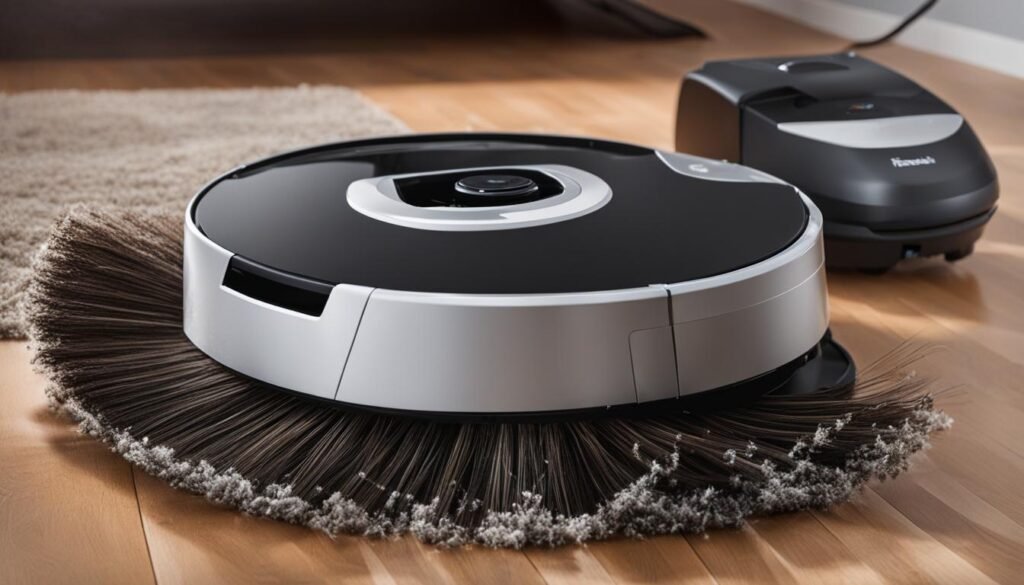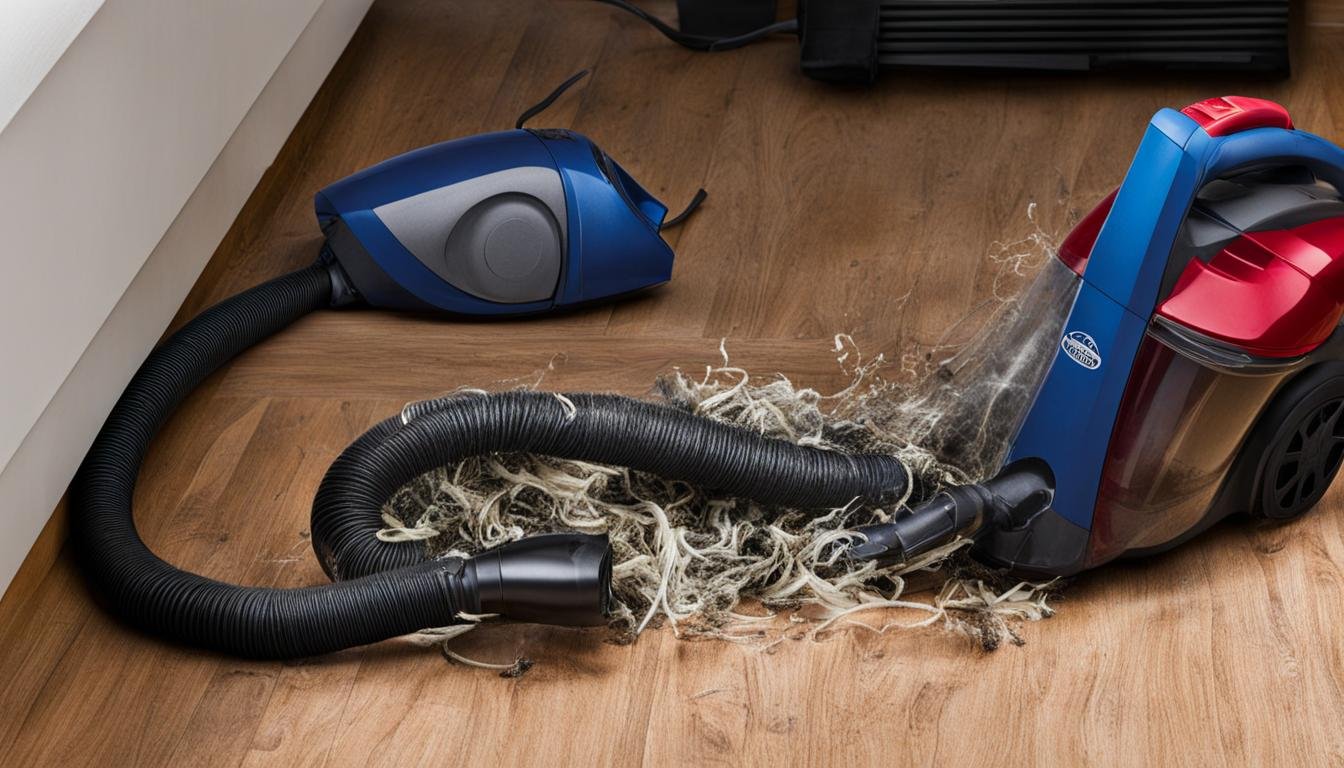The vacuum cleaner brush is a crucial component of any cleaning machine, as it effectively agitates and loosens dirt and dust from various surfaces. However, it can sometimes encounter issues such as not spinning, not working, or getting stuck, which can hamper the cleaning process. In this guide, I will provide you with practical tips and solutions to fix common vacuum cleaner brush problems, ensuring your machine operates at its best.
Key Takeaways:
- Common reasons for a vacuum brush not spinning include incorrect pile height adjustment, a clogged brush roll, a broken belt, motor problems, overstuffed dust bins, and loose seals and connections.
- To fix these issues, turn off hard floor mode, adjust the brush roll height, unclog the brush roll, replace a broken belt, empty the dust bin, tighten loose components, and consider seeking professional help if the motor is faulty.
- Robot vacuum cleaners offer advanced features such as navigation systems, obstacle detection, virtual barriers, self-emptying capabilities, and smart reminders to prevent brush spinning issues.
Troubleshooting Guide for Fixing a Vacuum Cleaner Brush
Is your vacuum cleaner brush not rotating? Are you having trouble with your vacuum cleaner brush not turning and picking up dirt effectively? Don’t worry, I’ve got you covered. In this troubleshooting guide, I’ll walk you through the steps to fix common issues that may cause your vacuum cleaner brush to jam, not engage, or fail to spin freely.
Identify the Root Cause
Before trying to fix the problem, it’s essential to identify the root cause of your vacuum cleaner brush not spinning. This will help you address the specific issue more effectively.
If your vacuum cleaner brush is not rotating, the first thing you should check is if the vacuum is in hard floor mode. Sometimes, this setting can prevent the brush from spinning. Switch off the hard floor mode and see if it resolves the problem.
Adjust the Brush Roll Height
Incorrect brush roll height can also be a reason for the brush not turning. Ensure that the brush roll is properly adjusted to have the right contact with the surface you are cleaning. This adjustment allows the brush to agitate the dirt effectively and pick it up.
Remove Debris from the Brush Roll
A clogged brush roll can hamper its rotation and prevent it from picking up dirt. Carefully inspect the brush roll and remove any debris or fibers that may have wrapped around it. Cleaning the brush roll regularly is critical to maintaining its proper functioning.
Inspect and Replace the Belt
If the brush roll is spinning freely but not engaging with the surface, a broken or damaged belt may be the culprit. Check the belt for signs of wear, tear, or breakage. If you notice any issues, replace the belt with a new one to restore proper brush roll functionality.
Empty the Dust Bin
An overstuffed dust bin can obstruct the rotation of the brush. Make it a habit to empty the dust bin regularly to ensure uninterrupted brush movement and optimal cleaning performance.
Tighten Loose Seals and Connections
Loose seals and connections can cause the brush not to engage or spin freely. Check all the seals and connections related to the brush and tighten them to ensure a secure power transfer. This will help maintain consistent brush rotation.
If, after following these troubleshooting steps, your vacuum cleaner brush is still not rotating, it’s advisable to seek professional help. They can assess the motor and perform any necessary repairs needed to restore the functionality of your vacuum cleaner brush.
Remember, a properly functioning vacuum cleaner brush is crucial for efficient cleaning, so don’t ignore any issues with its rotation. By addressing the problems promptly, you can enjoy optimal cleaning results and prolong the lifespan of your vacuum cleaner brush.
Now, let’s move on to the next section where we’ll discuss how robot vacuums can help prevent brush spinning issues and provide a hassle-free cleaning experience.
Preventing Vacuum Cleaner Brush Issues with Robot Vacuums

Robot vacuum cleaners offer advanced features that can prevent brush spinning issues. With cutting-edge technology and intelligent design, these robotic helpers are designed to tackle cleaning tasks efficiently and effectively.
One of the key features that sets robot vacuums apart is their navigation systems. For example, ECOVACS’s Truemapping system enables robots to identify different surfaces and switch to appropriate settings automatically. This ensures that the brush is optimized for the specific floor or carpet being cleaned, preventing issues like the brush not spinning or not picking up dirt effectively.
Obstacle detection sensors are another crucial component in robot vacuums. These sensors allow the robots to detect and avoid barriers in the cleaning path. Additionally, they enable the vacuum to adjust pile heights, ensuring the brush can climb over small objects and maintain optimal contact with the surface. By doing so, these sensors help prevent the brush from getting stuck and promote consistent performance.
Virtual barriers are a handy feature available in robot vacuums. By using the accompanying app, users can set virtual boundaries to avoid risky areas where the brush may become trapped or tangled. This prevents unnecessary wear and tear on the brush, contributing to a longer lifespan and reliable performance.
Furthermore, self-emptying docking stations found in top-tier smart vacuums offer a convenient solution for preventing brush issues. These docking stations automatically empty the dust containers, preventing overstuffing and ensuring uninterrupted brush rotation. With hassle-free maintenance, users can enjoy optimal performance from their vacuum brushes without worrying about clogs or malfunctions.
To further assist users in preventing vacuum cleaner brush issues, many robot vacuums come equipped with smart reminders. These reminders are sent through the app, notifying users when it’s time to clean or replace components. By promptly addressing these maintenance tasks, users can prevent potential problems and keep their vacuum brush in excellent working condition.
Key Points:
- Robot vacuum cleaners have advanced features such as navigation systems, obstacle detection, and virtual barriers to prevent brush spinning issues.
- The Truemapping system allows robots to identify different surfaces and adjust the brush settings accordingly.
- Obstacle detection sensors help the vacuum navigate around barriers and adjust pile heights for optimal brush performance.
- Virtual barriers can be set via the app to avoid risky areas where the brush may get stuck.
- Self-emptying docking stations prevent overstuffing and ensure hassle-free maintenance.
- Smart reminders sent through the app notify users when it’s time to clean or replace components.
Conclusion
Maintaining a properly functioning vacuum cleaner brush is crucial for effective cleaning. When faced with common issues like a brush not spinning, users can take steps to restore their vacuum cleaners to optimal performance.
By troubleshooting and addressing these problems promptly, individuals can avoid the frustration of a vacuum cleaner brush not working. The solutions may involve simple adjustments, such as turning off hard floor mode or adjusting the brush roll height, or more involved tasks like unclogging the brush roll or replacing a broken belt.
For those seeking a hassle-free cleaning experience, robot vacuum cleaners offer advanced features designed to prevent brush spinning issues. With navigation systems, obstacle detection, virtual barriers, and self-emptying capabilities, these smart vacuums provide optimized cleaning and minimize the risk of the brush getting stuck.
Remember, regular maintenance and proper use are key to prolonging the lifespan of your vacuum cleaner brush and ensuring efficient cleaning results. By following these guidelines and promptly addressing any issues that arise, you can keep your vacuum cleaner brush in top shape and enjoy cleaner, healthier living spaces.
FAQ
What are the common reasons for a vacuum cleaner brush not spinning?
The common reasons for a vacuum cleaner brush not spinning include the vacuum being in hard floor mode, incorrect pile height adjustment, a clogged brush roll, a broken belt, motor problems, overstuffed dust bins, and loose seals and connections.
How can I fix a vacuum cleaner brush that is not spinning?
To fix a vacuum cleaner brush that is not spinning, you can try the following troubleshooting steps:
– Check if the vacuum is in hard floor mode and switch it off.
– Adjust the brush roll height to ensure proper contact with the surface being cleaned.
– If the brush roll is clogged, remove any debris or fibers that may be wrapped around it.
– Inspect the belt for damage or breakage, and replace it if necessary.
– Empty the dust bin regularly to prevent obstruction of the brush rotation.
– Tighten any loose seals and connections to ensure a solid power transfer to the brush.
What should I do if the vacuum cleaner brush still doesn’t spin after troubleshooting?
If the vacuum cleaner brush still doesn’t spin after troubleshooting, it may indicate a motor problem. In such cases, it is recommended to seek professional help for further assessment and repair.
What features do robot vacuum cleaners have to prevent brush spinning issues?
Robot vacuum cleaners have advanced features such as navigation systems, obstacle detection, virtual barriers, self-emptying capabilities, and smart reminders. These features help prevent brush spinning issues and provide a hassle-free cleaning experience.
– Navigation systems, such as ECOVACS’s Truemapping system, allow robots to identify different surfaces and switch to appropriate settings automatically.
– Obstacle detection sensors help robots avoid barriers and adjust pile heights to climb over objects.
– Virtual barriers can be set via the app to avoid risky areas where the brush may get stuck.
– Self-emptying docking stations in top-tier smart vacuums prevent overstuffing the dust containers and ensure hassle-free maintenance.
– Smart reminders sent through the app notify users when it’s time to clean or replace components, allowing for prompt action to fix any potential problems.
How can I ensure efficient cleaning results with a vacuum cleaner brush?
To ensure efficient cleaning results with a vacuum cleaner brush, it is important to maintain it properly. This can be done by troubleshooting and fixing common issues, such as a brush not spinning, and regularly cleaning and replacing components as needed. Following the manufacturer’s instructions for use and conducting routine maintenance can help prolong the lifespan of the vacuum cleaner brush and maintain optimal cleaning performance.





Leave a Reply